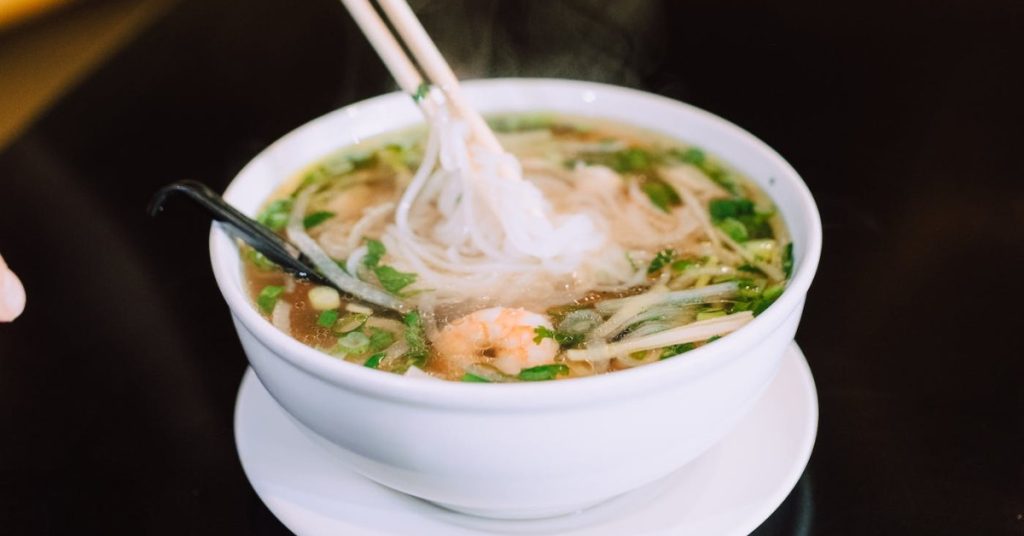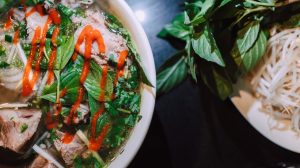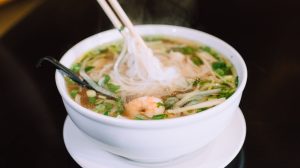
Thai Noodle Soup and Vietnamese Pho are extremely popular dishes originating in Asia. These dishes are a staple of their respective cultures and are served across Asia and other parts of the world. The similarities between Thai Noodle Soup and Vietnamese Pho are striking.
Both are served with a fresh, steaming broth seasoned with ginger, spices, vegetables, and meats. Both also have a wide array of toppings that can be added to the broth before eating. Additionally, both dishes are served with noodles, meat, vegetables, and herbs. In terms of preparation, both are broth bases made from beef or chicken bones and contain thinly sliced meats cooked separately.
However, both have distinct differences in ingredient selection, taste, and how both are served, making each dish unique. So let’s dive deeper into the details.
Thai Noodle Soup
Thai Noodle Soup is a flavorful, delicious, and nutritious dish for lunch or dinner. It’s also easy to make at home, so you can save money by making it yourself instead of eating at a restaurant.
The main ingredients in Thai Noodle Soup are rice noodles made from rice flour and water. The noodles are typically served in a clear broth with vegetables, tofu, or seafood added for extra flavor.
There are many different recipes for Thai noodle soup, but most start with boiling water and adding it to the pot along with some meat (such as chicken or beef), vegetables such as chopped onions and carrots, plus garlic cloves if desired. Then add spices like ginger root powder, allspice, nutmeg, cardamom, black pepper, cayenne pepper, turmeric powder, chili powder, basil leaves, coriander seeds, paprika cumin seeds, cinnamon sticks, bay leaf salt, fish sauce, soy sauce, oil, sugar vinegar, peanut butter, ketchup red curry paste green curry paste yellow.
Vietnamese Pho
Vietnamese Pho is a popular noodle soup with beef, chicken, or seafood broth. It can be served with beef, chicken, shrimp, or tofu and garnished with fresh basil and cilantro.
Pho is a popular Vietnamese soup with rice noodles, broth, and meat. The broth is typically flavored with onions, ginger, and fish sauce, and it’s served with fresh herbs like Thai basil and cilantro. Pho is often eaten for breakfast in Vietnam because it’s filling without being heavy or greasy.
Pho is usually eaten as a breakfast food in Vietnam but is also popular as an appetizer and lunch or dinner dish.
Pho can be prepared at home using store-bought broth and store-bought rice noodles. However, to make Pho from scratch without using pre-made ingredients, you must prepare your broth using bones from a cow (or other animals). You’ll also need to make your rice noodles using rice flour.
Thai Noodle Soup vs. Vietnamese Pho: Broth preparation, taste, and flavor.
Thai Noodle Soup uses simpler ingredients like fish sauce (a salty sauce made from fermented fish), lime juice, and chili paste. In addition, the soup contains chicken or pork and vegetables like cilantro, bean sprouts, and green onions.
Pho broth takes hours to prepare. It uses soy sauce (a salty sauce made from fermented soybeans), beef broth flavored with star anise, onions, and ginger. Meat options include beef or chicken and various fresh herbs such as cilantro, basil, and mint.
Broths for both dishes have similar ingredients, including onions, ginger, garlic, lemongrass, fish sauce, and coriander root. However, Pho contains only limited vegetables like onions and cilantro (coriander), but Thai Noodle Soup contains various vegetables such as onions, broccoli, mushrooms, carrots, and other herbs.
Thai Noodle Soup has a more Asian-inspired flavor than Vietnamese Pho; they often include coconut milk and tamarind pulp for their signature taste.
Pho has more of an herbal taste due to its use of fresh herbs like cilantro or basil leaves and lemon or lime juice squeezed over the top at serving time (or just before eating). Thai noodle soup comes in various flavors, including red curry and yellow curry.
Thai Noodle Soup vs. Vietnamese Pho: The noodles
Thai noodles are usually flat and thin, while Vietnamese noodles can be round or flat but always soft and smooth. In addition, Thai noodle soup contains different types of noodles, such as egg noodles, rice noodles, and vermicelli noodles. At the same time, Vietnamese Pho typically has only one type of noodle—rice noodles.
Thai Noodle Soup vs. Vietnamese Pho: Garnishing and Serving
Thai Noodle Soup and Vietnamese Pho are served in a bowl with broth, rice noodles, and meat, but they differ in their primary ingredients. However, Pho is a hot soup, while Thai Noodle Soup may be served cold.
Both dishes are served with bean sprouts and cilantro on top. However, adding fresh basil leaves, sliced green onions, cilantro, and lime wedges to the dish is common in Thai cuisine. Vietnamese cuisine usually adds chopped scallions, jalapeño slices, or popular Vietnamese sauce.
Thai Noodle Soup vs. Vietnamese Pho: Condiments
Thai Noodle Soup is served with various sauces, including fish sauce, chili paste, soy sauce, lime juice, and sugar. Vietnamese Pho is also served with sauces like hoisin, chili, garlic, or even sriracha.
The condiments for both dishes are usually served on the side, so people can choose their combination of spices and toppings to make their soup suit their tastes.
Use fresh cilantro and lime juice in Thai Noodle Soup for a refreshing kick. The broth is milder than Pho’s beefy soup base and flavored with lemongrass and galangal root (a type of ginger). Vietnamese Pho usually tastes better with hot sriracha sauce. If you’re feeling adventurous, add some hoisin sauce or chili oil.
Conclusion
Pho and Thai noodle soup are delicious dishes you can enjoy any time of the year. They’re both served with noodles, meat, and vegetables in a rich broth, but they have different flavors and garnishes. If you want something spicy and flavorful, go with the Thai Noodle Soup, but if you prefer something lighter, order some Vietnamese Pho.





















Nice read, I just passed this onto a friend who was doing a little research on that. And he actually bought me lunch as I found it for him smile So let me rephrase that: Thanks for lunch!
Great lunch!